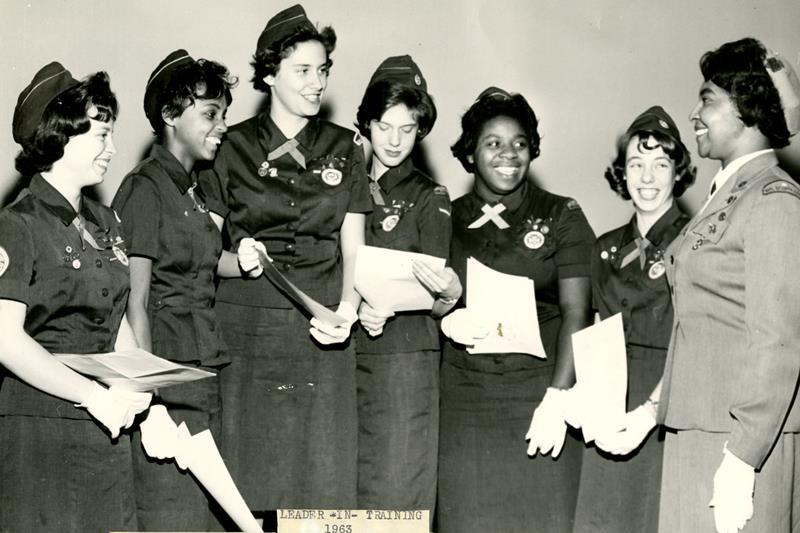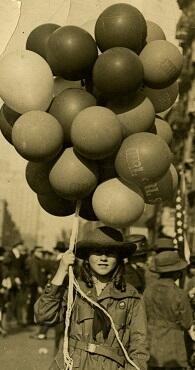
March 19, 2014
A century of leadership
Share this story
At first glance, the Girl Scout uniforms of the 1970s – a polyester pantsuit – may appear to be little more than a fashion misstatement. In fact, the wash-and-wear pants were significant. As the women’s equality movement progressed, Girl Scout leaders wanted girls to learn that a career beyond homemaking was possible. New programs and badges focused on skills that could apply to professional lives. That easy-care uniform with slacks — at a time when many schools and workplaces had dress codes prohibiting some women’s fashion choices — was a symbol of liberation and of changing times.
This 1972 uniform is just one of many items on display in the VCU Libraries’ exhibition, "Girl Scouts of the Commonwealth of Virginia: A Century of Leadership, 1913-2013." Uniforms, photos, badges, cookie boxes and other documents and ephemera were donated by the Commonwealth Council to document a century of leadership and service from Virginia’s Girl Scouts.
From the founding of the first troop in Virginia just a year after the national organization began to the creation of the first African-American troop in the South, the local council has provided education, encouragement and enjoyment for thousands of Virginia girls since 1913.
“We are very proud of the visible history that we continue to make,” said Viola Baskerville, CEO of the GSCV. “We are making many strides in Girl Scouts; this is the century of leadership.”
The items on display were chosen to represent the theme of leadership and to show the intersection of the Girl Scouts with many pivotal moments in history, according to Yuki Hibben, assistant head of special collections and archives at James Branch Cabell Library.
“The exhibit reflects the history of women’s service during World War II, the badges and programs from the ‘70s show more focus on career options…and in the ‘80s, the Girl Scouts championed social causes such as homelessness,” Hibben said. “The artifacts mixed with photos help capture this rich story.”
This collection is an important addition to existing VCU Libraries holdings on African-American and women's history. The Girl Scout collection will enhance VCU Libraries' strong archival holdings documenting the history of women in Central Virginia.
The exhibit documents a variety of changes, from the design of the badges to more profound changes in Virginia, women’s and other history.
The first Girl Scouts troop was founded by Juliette Gordon Low in Savannah, Ga., in 1912. Low wanted girls to have the same education and development opportunities as boys, and focused on core values such as environmental stewardship, diversity and inclusion, global citizenship, educational enrichment and public service. The first Virginia group, Pansy Troop No. 1, started in Highland Springs, Va., just one year later.
“The idea of scouting has military origins – youth serving as reconnaissance, youth contributing at home while troops were away,” Hibben said. Early Girl Scout programs focused on many of the same skills taught by Boy Scouts, using outdoor activities to promote confidence and health.
“I liked anything outdoorsy, and I did 10 years at the Girl Scout summer camp,” said Eleanor Sharp, a former Girl Scout and current troop leader. “I have nieces…and I love teaching them outdoor skills… I mean, how often do you get to sit around a campfire, pitch your own tent, learn what things are safe to eat?”
But outdoor skills were not the only focus of the Girl Scouts, and other issues became more prominent as they progressed.
In 1932, Troop No. 101 was established on the Virginia Union University campus as the first African-American Girl Scout troop below the Mason-Dixon Line. Today, the CEO of the GSCV is an African-American woman.
“When I was a Girl Scout in the ‘60s, we had segregated camps,” said Stephanie Holt, a former Girl Scout and a member of the Friends of VCU Libraries. “It boggles my mind now…but I didn’t know Virginia had the first African-American troop [in the South].”

While skill sets and membership has changed, the mission of the Girl Scouts has largely stayed the same.
“Girl Scouts bridge the gap from girlhood to womanhood, but they’re also closing the gender gap on so many things, and leadership is key to that,” said Tamara Johnson, director of donor services for the GSCV. “There are more and more female CEOs, more women in Congress. They’re finding their voices and being heard now.”
The exhibition "Girl Scouts of the Commonwealth of Virginia: A Century of Leadership, 1913-2013" will be on view throughout spring semester 2014. It is expected to draw hundreds of scouts, leaders and alumni, including many members of the VCU community. Free and open to all, it is on view during regular Cabell hours on the fourth floor. For library hourse, visit http://www.library.vcu.edu/about/libraries/cabell/hours/.
Shots of elements in the cases by Amber Taber, VCU Libraries PR Intern and Photographer
Subscribe for free to the weekly VCU News email newsletter at http://newsletter.news.vcu.
Subscribe to VCU News
Subscribe to VCU News at newsletter.vcu.edu and receive a selection of stories, videos, photos, news clips and event listings in your inbox.



